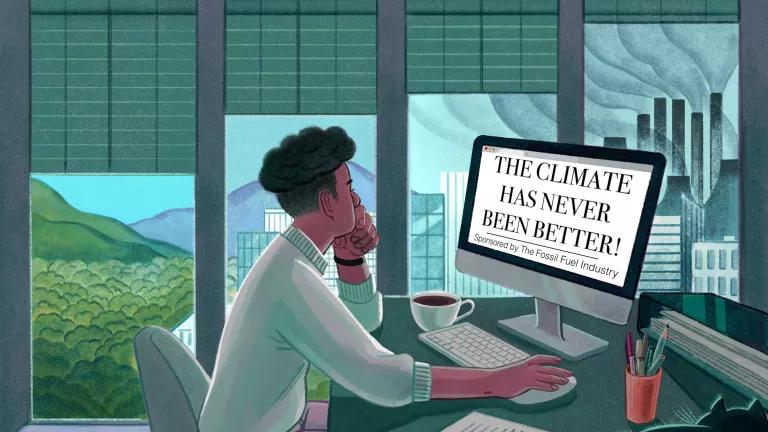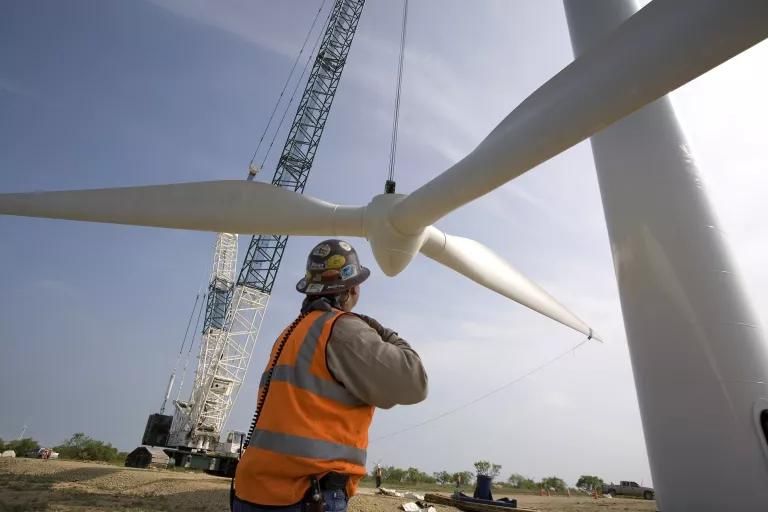Climate Misinformation on Social Media Is Undermining Climate Action
At their worst, social platforms are ideological echo chambers where falsehoods can’t be set straight. To fossil fuel interests, that sounds perfect.

Ericka Lugo for NRDC
To hear some climate scientists and activists tell it, there are actually encouraging signs that climate skepticism is on the decline. The evidence for climate change that’s all around us—temperatures in Antarctica were recently 70 degrees Fahrenheit warmer than they’re supposed to be—has made it harder and harder for deniers to, well, deny.
But fossil fuel interests can’t afford to let public opinion settle on the side of science. And so, with their profit margins very much on the line, these interests have replaced outright denial with spreading climate misinformation meant to undermine climate science and solutions. Their aim is to sow enough doubt to delay real climate action.
Unfortunately, our current social media ecosystem makes doing so all too easy.
What Exactly Is Climate Misinformation?
Misinformation is just what it sounds like: the sharing of information that is false or incorrect. When someone deliberately spreads misinformation with the intent to mislead, we call it disinformation. Much of this intentionally misleading content about climate change or renewable energy is funded by a handful of industries, particularly the fossil fuel industry, and often conceived by conservative think tanks and front groups. Then various “influencers” like these help amplify it.
The average individuals who end up resharing this content aren’t necessarily trying to mislead; they may feel like they’re merely “asking questions,” or that they’ve happened upon an underreported news story worth passing along. By this point, the distinction between disinformation and misinformation can be almost nonexistent. What’s important to fossil fuel interests is that the information is out there, circulating.
Why Does the Spread of Climate Misinformation Matter?
Every falsehood, distortion, and conspiracy theory about climate change is an obstacle to meaningful climate action—which is a collective effort that requires our agreement on a set of basic facts. The fossil fuel industry’s current strategy is to encourage disagreement about these facts as a means to foster division. And research has shown it works, contributing to everything from political inaction to the rejection of mitigation policies. Of course, the fossil fuel industry expected that. Spreading misinformation on social media is just a mutation of what they’ve done offline for decades. It’s also a page right out of the tobacco industry’s playbook. A comprehensive 2020 report on climate misinformation quoted language from a memo by a tobacco-industry executive explaining how the same tactics were employed during that industry’s decades-long attempt to suppress the impact of scientific studies linking cigarettes to cancer: “Doubt is our product, since it is the best means of competing with the ‘body of fact’ that exists in the minds of the general public. It is also the means of establishing a controversy.”
How Does It Play Out Online?
Fossil fuel companies, other major polluters, and their allies have spent hundreds of millions of dollars to spread false and misleading content on social media. One analysis found that 16 of the world's biggest polluters were responsible for placing more than 1,700 of these ads on Facebook in 2021. Collectively, those ads garnered roughly 150 million impressions and have earned nearly $5 million for the platform.

The Lone Star Wind Farm in Abilene, Texas
Robert Nickelsberg/Getty Images
Clean energy is a favorite target of these 21st-century social media merchants of doubt. For example, the Texas Public Policy Foundation, a think tank with strong ties to the oil and gas industry, has inserted itself into regional conflicts over wind energy by making YouTube videos framing these battles as clashes between local, small business Davids against multinational, clean energy Goliaths. Last fall, ExxonMobil paid for at least 350 ads intended to influence proposed legislation in New York state that would phase out natural gas in new buildings. And knowing that users are far more likely to trust political information that appears to be coming from grassroots organizations over information that is clearly identifiable as corporate advertising, oil and gas companies have become skilled at fabricating front groups that look, sound, and act like nationwide collections of “concerned” citizens. (Spoiler alert: They are not.)
Climate misinformation has even been incorporated into the marketing plans to help sell the public on the continued use of fossil fuels. Trade groups for the natural gas industry have actually paid Instagram influencers—often young women with large followings among foodies and cooking enthusiasts—to talk up the benefits of cooking on a gas stove as opposed to an electric one, in an effort to make the burning of this particular fossil fuel seem like a requirement for successful recipe outcomes.
Much of this overall messaging is often reinforced by the biggest individual spreaders of misinformation online, some of whom receive funding from fossil fuel interest groups.
What Makes Social Media the Perfect Breeding Ground?
Researchers at Indiana University have identified three separate but interrelated kinds of bias that, in their words, “make the social media ecosystem vulnerable to both intentional and accidental misinformation.”
Cognitive biases are systematic errors in thinking that stem from our propensity to use mental shortcuts. Social bias is the tendency to trust information that comes from people you know (or with whom you identify) over information from other sources. And algorithmic bias comes courtesy of social media platforms themselves: Sites like Facebook and Twitter tailor the content that you see every day based on what they predict you’ll react to most passionately—whether your reaction is one of joy, sympathy, or anger.
Together, this is basically a recipe for discourse disaster. Cognitive bias means we’re much more likely to believe—and share—information that sounds true to us without taking the time to confirm whether it is, indeed, true. Social bias means that we’re even more likely to believe and share that information if it has come to us via someone in our social (or ideological) circle. And algorithmic bias means that once we’ve liked and shared this bit of maybe-true, maybe-not-true information, we’re going to be seeing a lot more posts in the same vein.
Add to this the tiny yet significant dopamine rush that people experience from having others like and/or share their posts, and you essentially have a machine built for unfettered, unfiltered messaging. If you’re an oil and gas executive or think tank analyst bent on killing clean energy, you couldn’t devise a better means of getting the word out—and making it stick.
How Have Social Media Platforms Responded?
Social media sites have been rife with climate and clean energy misinformation for years—and their responses to this growing problem have been unsatisfyingly mixed, at best. After one research organization found that Twitter had allowed nearly half a million posts that deny climate change to appear on its platform in 2020, the site added a new climate change topic in order to steer activity toward scientifically accurate sources. It has also tweaked its algorithms to direct users toward credible information before they encounter misinformation, a strategy known as “pre-bunking.”
In October, YouTube’s parent company, Google, announced that the popular video site would no longer allow creators to earn money from content that “contradicts well-established scientific consensus around the existence and causes of climate change.” That hasn’t put an end to misleading or deceptive content on these platforms, however. (For proof, just type the words “climate change hoax” into the platforms’ search bars and see what comes up.)
Last year, Facebook—the world’s most visited social media platform—announced that it would begin attaching warning labels to certain content and directing readers to a “climate science information center” containing accurate information. But a report issued in February from a watchdog group found that Facebook had in fact “fail[ed] to label half of the posts promoting articles from leading publishers of climate denial.” That came on the heels of damning congressional testimony from ex-Facebook employee–turned–whistleblower Frances Haugen, who revealed that her former employer intentionally misled the public, including potential investors, about its efforts to fight climate misinformation.
One potential bright spot might be the response by Pinterest, which recently announced it would ban all climate misinformation from posts and ads.
What—if Anything—Can We Do About the Problem?
Congressional Republicans and Democrats have come together at different points to grill the CEOs of Facebook and Twitter about the negative impact their business practices have had on civil discourse. And though there has been some momentum in the direction of increased regulation, concerns about free speech—along with more practical concerns about the difficulty of fact-checking social information in real time—have hindered any real attempts to address the issue legislatively.
That pretty much leaves it up to us—social media users—to do a better job of separating online fact from online fiction. Fortunately, there are some tools at our disposal, which may be all we’ll have for some time. After all, we’ve known for a minute now that misinformation, much like climate change, is a serious problem more broadly.
Right after the 2020 election, a CNN interviewer asked former president Barack Obama for his thoughts on why America seemed to be so divided along political and ideological lines. Almost without hesitation, Obama pointed to the power of our fractured media landscape to reinforce bias and give the patina of plausibility to untruths. "It's very hard for our democracy to function if we are operating on just completely different sets of facts," he said. Keep in mind, this sentence was uttered before the rise of the wholly unsubstantiated “Big Lie” promulgated by Donald Trump—that the 2020 presidential election was stolen from him through massive voter fraud—and before a not-insignificant number of Americans began rejecting the lifesaving COVID-19 vaccine based on fears that it might contain microchips.
To most of us, these are the symptoms of what President Obama, in a separate interview, deemed “an epistemological crisis.” But to the merchants of climate and clean energy disinformation, they’re welcome mats. If the good news is that more and more people are accepting the reality of climate change, despite decades’ worth of attempts by fossil fuel interests to mislead us, the bad news is that these same interests have adopted a new tack. Social media is their secret weapon. And our current cultural proclivity for disagreement on nearly everything—including objective reality—is their strategic advantage.
This NRDC.org story is available for online republication by news media outlets or nonprofits under these conditions: The writer(s) must be credited with a byline; you must note prominently that the story was originally published by NRDC.org and link to the original; the story cannot be edited (beyond simple things such as grammar); you can’t resell the story in any form or grant republishing rights to other outlets; you can’t republish our material wholesale or automatically—you need to select stories individually; you can’t republish the photos or graphics on our site without specific permission; you should drop us a note to let us know when you’ve used one of our stories.


Liquefied Natural Gas 101
What Are the Solutions to Climate Change?
What Are the Causes of Climate Change?